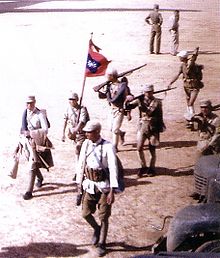Military history of China
The recorded military history of China extends from about 2200 BC to the present day. This history can be divided into the military history of China before 1911, when a revolution overthrew the imperial state, and the period of the Republic of China Army and the People's Liberation Army.
Pre-modern period
Although the traditional Chinese Confucian philosophy favored peaceful political solutions and showed contempt for brute military force, the military was influential in most Chinese states. The Chinese pioneered the use of crossbows, advanced metallurgical standardization for arms and armor, early gunpowder weapons, and other advanced weapons, but also adopted nomadic cavalry[1] and Western military technology.[2] In addition, China's armies also benefited from an advanced logistics system as well as a rich strategic tradition, beginning with Sun Tzu's The Art of War, that deeply influenced military thought.[3]
Modern period
People's Liberation Army
Chinese military history underwent a dramatic transformation in the 20th century, with the People's Liberation Army beginning in 1927 with the start of the Chinese Civil War, and developing from a peasant guerrilla force into what remains the largest armed force in the world.
Republic of China Army

The Republic of China Army was founded as the National Revolutionary Army, the armed wing of Sun Yat-sen's Kuomintang (KMT) in 1924. It participated in the Northern Expedition, the Second Sino-Japanese War (during World War II) and the Chinese Civil War before withdrawing with the ROC government to Taiwan in 1949. After 1949, the ROC Army has participated in combat operations on Kinmen and the Dachen Archipelago against the PLA in the Battle of Kuningtou, and in the First and Second Taiwan Strait Crisis. In addition to these major conflicts, ROCA commandos were regularly sent to raid the Fujian and Guangdong coasts. Until the 1970s, the stated mission of the Army was to retake the mainland from the People's Republic of China. Following the lifting of martial law in 1988 and Taiwanese democratization of the 1990s, the mission of the ROC Army has been shifted to the defense of Taiwan, Penghu (the Pescadores Islands), Kinmen and Matsu from a PLA invasion.
With the reduction of the size of the ROC armed forces in recent years, the Army has endured the largest number of cutbacks as ROC military doctrine has begun to emphasize the importance of offshore engagement with the Navy and Air Force. After this shift in emphasis, the ROC Navy and Air Force have taken precedence over the ROC Army in defense doctrine and weapons procurement.[4] Recent short-term goals in the Army include acquisition and development of joint command and control systems, advanced attack helicopters and armored vehicles, multiple launch rocket systems and field air defense systems. The Army is also in the process of transitioning to an all volunteer force.[5]
See also
References
- ^ H. G. Creel: "The Role of the Horse in Chinese History", The American Historical Review, Vol. 70, No. 3 (1965), pp. 647–672 (649f.)
- ^ Frederic E. Wakeman: The Great Enterprise: The Manchu Reconstruction of Imperial Order in Seventeenth-century China, Vol. 1 (1985), ISBN 978-0-520-04804-1, p. 77
- ^ Griffith (2006), 1
- ^ Roy, Denny (2003). "Taiwan's Threat Perceptions: The Enemy Within" (PDF). Asia-Pacific Center for Security Studies.
{{cite journal}}: Cite journal requires|journal=(help) See "Reforming the Armed Forces", page 5. - ^ "2004 National Defense Report" (PDF). ROC Ministry of National Defense. 2004. Archived from the original (PDF) on 2006-03-11. Retrieved 2006-03-05.
Further reading
- Fravel, M. Taylor. Active Defense: China’s Military Strategy since 1949 (Princeton University Press, 2019) online reviews
